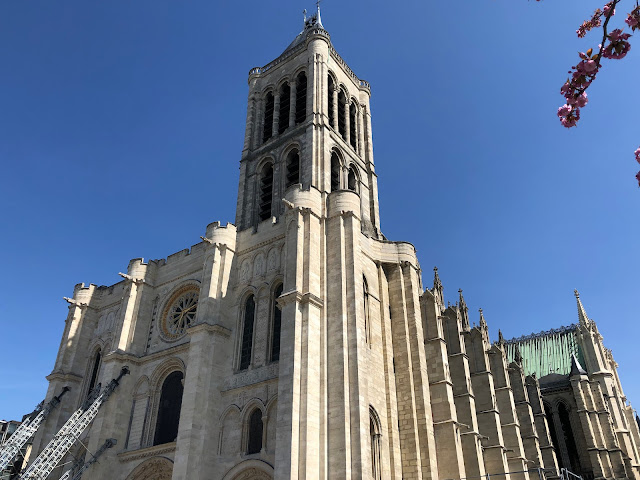The Basilique Cathédrale de Saint-Denis is just a 45 minute metro ride from our apartment. It's notable mainly for two things: it's the first example of what is considered Gothic architecture (e.g. the rose window and lots of other glass to light the interior, vaulted ceilings with cross-ribs); it contains (or once contained) the remains of most of France's kings and queens going to back to the Frankish King Dagobert who died in 639.
 |
| Exterior views of the Basilique Cathédral de Saint-Denis. |
I've been in some very old churches, but Saint-Denis--from the 12th and 13th century--showed none of the typical decay and gloom. The gargoyles and demons crawling around the exterior all seemed to have their snouts and horns mostly intact, and the interior was bright and free of mold and mildew. This is in spite of the fact that the church was sacked and abandoned during the Revolution, and by the time of Napoleon I's ascension birds and grasses had taken over in the nave.





The necropolis of the French great and mighty perhaps gives Saint-Denis a leg up on other Gothic churches: visiting the church is free, but to see the area where the remains, funerary art, and recumbent effigies are kept costs 9 euros. It's definitely worth the price of admission--and a bargain considering that "forty-two kings, thirty-two queens, sixty-three princes and princesses and ten men of the kingdom rest in peace there." Assuming they were all equally in demand to visitors (which they are not), you're seeing the A-list of french royalty for under a dime apiece.
 |
| The welcoming sign just as you enter the necropolis. |
And it is a "who's who" of French royalty, including Catherine de Medici, Charles V, and Henri IV. It's also a "who almost was" in the form of the mummified heart of Louis-Charles the Dauphin, who would have inherited the throne as Louis XVII, but died at age 10 in a Revolutionary prison instead.
But here is where it gets a fuzzy in terms of what it actually means to remain within Saint-Denis. The Revolutionaries basically evicted the slumbering royals to a mass grave on the outside grounds. And of course, the decapitated bodies of Louis XVI and Mari-Antoinette had been tossed in a different mass grave and covered in quicklime elsewhere in Paris. The restored Bourbon king Louis XVIII had the mass grave at Saint-Denis exhumed and the royal remains--including what little was left of the bodies of Louis XVI and Marie-Antoinette--placed in an ossuary within the crypt.
So everyone's back together, but not necessarily in the their original coffins and memorials in the church necropolis.
 |
| The crypt entrance. |
 |
| A monument to the Sun King, Louis XIV. |
 |
| Marie-Antoinette, kneeling in prayer, head intact. |
Regardless, it's a fascinating place for funerary art, particularly the recumbent effigies. The first of these were commissioned by Louis IX (Saint Louis) in the 13th century for 16 of his predecessors. The tradition continued until they ran out space for Henry IV in 1610--which began the new tradition of placing Bourbon royalty in the crypt.
One curious detail of the recumbent effigies is the placement of small animals at the reclined person's feet. For women, these were usually small dogs (a symbol of fidelity), while men often had very miniature lions, for all the reasons one might suspect. More baffling were animals such as ferrets and what appeared to be possums.
.jpeg) |
| Two faithful pups at the feet of Jeanne de Bourbon (died 1377). |
 |
| A ferret at the feet of Isabeau de Bavière (died 1435). |
 |
| Medieval dog with bunny. |
 |
| Modern dog with bunny. |
As is usual with medieval churches, in spite of the realism achieved by artisan sculptors, there are always animals and fanciful creatures that cannot be identified. It's tempting to call the example below a werewolf, which has precedent in the lore of some Catholic saints--but those stories are typically associated with Saint Patrick and other notables of Ireland. But given how the Normans got around Europe and Britannia, who knows.
 |
| Probably not a werewolf. |












.jpeg)







Comments
Post a Comment